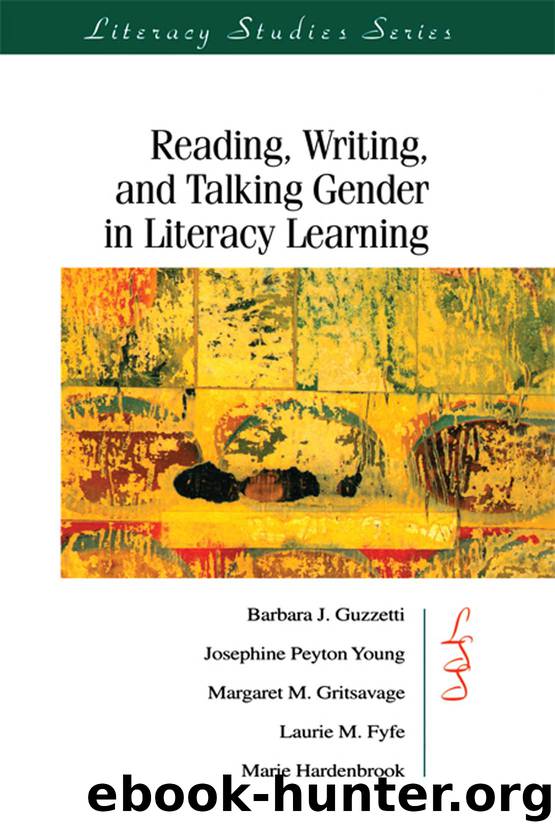Reading, Writing, and Talking Gender in Literacy Learning by unknow

Author:unknow
Language: eng
Format: epub
Publisher: Taylor & Francis Group
Discussion
Each of these studies illustrated one of four themes: (1) the importance of text and method in literature response; (2) gendered reading preferences and practices; (3) oppression or constraint of instructional and social context; and (4) opposition, accommodation, and resistance in reading. The first of these themes, the importance of text and method in reader response, addressed the conditions that make peer-led discussions successful. When reader response is interpreted as students putting themselves in the place of a character and relating their own experiences to those of the character, studentsâ tendencies are to bring their stereotypical understandings of gender to their readings. Children also have a tendency to think in terms of boysâ books and girlsâ books and respond accordingly. These works of fiction can be an enculturating mechanism by which males and females learn or reinforce their traditional gender roles.
To counteract these tendencies, it is important that students be exposed to books that portray both females and males in nontraditional roles. Also, the typical lack of structure in literature-response groups allows students to speak to each other in ways informed by their gendered beliefs in both their language patterns and their interpretations. When teachers become active participants in these groups and present and discuss alternative models of gender representation, students can be helped to deconstruct their gendered understandings.
The second theme, gendered reading preferences and practices, illustrated how ingrained studentsâ understandings of gender constrain and are reinforced by their texts of choice. Researchers noted a multiplicity of ways in which gender, as a social construction, influenced studentsâ choices and responses to literature. Most students preferred to read books about characters of their own sex in which males were adventurers and females nurturers of relationships. Boys tended to prefer nonfiction (aside from male-oriented, superhero comic books) and did not relate well to in-school reading in which most literature consisted of the fiction preferred by females. Teenage girls preferred to read romance novels or teen magazines, which was a form of reading not presented or valued in schools.
These discrepancies between studentsâ in-school reading requirements and their out-of-school reading preferences may cause both males and females to enjoy and relate to their out-of-school reading more than their in-school reading. These unsanctioned texts can have powerful impacts on their readers. For example, girlsâ reading of teen romance novels and magazines can teach them values of consumerism, guide their behavior in interacting with boys, and reinforce their social-class positions; young males reading comics may find models of moral behavior while absorbing society's notions of masculinity as powerful, tough, successful, and independent.
These studies show the importance of bridging the gap between studentsâ out-of-school reading and their in-school reading. Perhaps, if teachers were to allow studentsâ reading choices like these into the classroom as Osmont (1987) did and teach students how to deconstruct them, studentsâ selections and interpretations of texts might be less gendered. Making students aware that they can be positioned by the texts that they read will help them to develop as critical readers, will expand their notions of what counts as reading, and will help them to read strategically.
Download
This site does not store any files on its server. We only index and link to content provided by other sites. Please contact the content providers to delete copyright contents if any and email us, we'll remove relevant links or contents immediately.
Macmillan Primary Grammar 2 Pupil's Book by Unknown(409)
Figuring Out Fluency in Mathematics Teaching and Learning, Grades K-8 by Jennifer M. Bay-Williams & John J. SanGiovanni(369)
The Principal's Guide to Curriculum Leadership by Sorenson Richard D.;Goldsmith Lloyd M.;Mendez Zulma Y.;Maxwell Karen T.;(292)
Learning from Accidents 3rd ed by Trevor Kletz (2001)(255)
English Grammar Practice--The Noun by Roxana Nastase(253)
Harnessing Technology for Deeper Learning by Scott McLeod(246)
Text-Dependent Questions, Grades K-5 by Douglas Fisher & Nancy Frey & Heather Anderson & Marisol Thayre(231)
A Guide to Curriculum Mapping by Hale Janet A.;(227)
English Language Program Administration by Unknown(218)
How to Do Everything with Google Tools by Unknown(215)
Deep Change Leadership by Reeves Douglas;(208)
The Grammar Teacher's Activity-a-Day by Jack Umstatter(202)
The Power of SMART Goals by Conzemius Anne;O'Neill Jan; & Anne Conzemius(193)
Beyond the RTI Pyramid by Bender William N.;(175)
Aligning and Balancing the Standards-Based Curriculum by Squires David A.;(172)
Using Data to Close the Achievement Gap by Johnson Ruth S.;(169)
Using Equity Audits to Create Equitable and Excellent Schools by Skrla Linda E.;McKenzie Kathryn B.;Scheurich James Joseph;(167)
Differentiated Instructional Strategies for the Block Schedule by Gregory Gayle H.;Herndon Lynne E.; & Lynne E. Herndon(166)
You've Got to Reach Them to Teach Them by Schreck Mary Kim; & Schreck(158)
